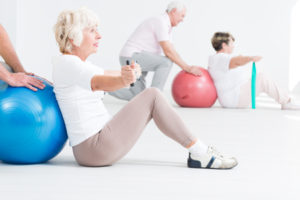
It came as no surprise to Meth-Wick staff that “programs for older adults” is predicted by fitness professionals worldwide to be one of the year’s top 20 fitness trends. Meth-Wick’s priority is to help each resident live their best life, and this includes providing leading-edge wellness and fitness programs.
In its report on 2017 fitness trends, the American College of Sports Medicine (ACSM) ranked fitness programs for seniors at eleventh place and another aspect of senior wellness, functional fitness, followed on its heels in twelfth place.
Compared to previous ACSM surveys, fitness programs for older adults slipped a bit. It took eighth place in 2016 and 2015. But this trend is likely to stay strong in future top 20 trends as baby boomers transition into retirement.
Trend vs. fad
ACSM has released its fitness trend report every year since 2007. The editors of ACM’s Health & Fitness Journal annually route an electronic survey to health fitness professionals worldwide with the intention of guiding health fitness programming.
In its summary of survey results, ACSM’s President-Elect Walter Thompson writes:
“These annual surveys of health fitness trends in the commercial (usually for-profit companies), clinical (including medical fitness programs), community (not for profit), and corporate divisions of the industry continue to confirm previously identified trends.”
The ACSM survey appears to have merit as a predictor of what’s hot in fitness. Certified, experienced professional trainers and strength training have stayed in top trends since being identified by the survey 11 years ago.
Here’s a list of ACSM’s top 20 fitness trends for 2017. Many may look familiar if you participate in Meth-Wick’s fitness and wellness programs.
- Wearable technology. Activity trackers, smart watches, heart monitors, etc.
- Body weight training. Using your body for resistance rather than weights.
- High intensity interval training. Short bursts of intense exercise followed by short periods of rest.
- Educated, certified and experienced fitness professionals.
- Strength training. Using weights.
- Group training. Exercise classes with five or more participants.
- Exercise is medicine. This is a global initiative encouraging doctors to include physical activities in treatment plans.
- Yoga
- Personal training.
- Exercise and weight loss.
- Programs for older adults.
- Functional fitness. Using strength training to improve one’s ability to perform daily living tasks.
- Outdoor activities.
- Group personal training. Personal trainer instructs 2-4 clients in the same session, at a discounted rate.
- Wellness coaching.
- Worksite health promotion.
- Smart phone exercise apps.
- Outcome measurements.
- Circuit training. Exercises completed in succession for optimum benefit.
- Flexibility and mobility rollers. Usually made of foam, used to improve circulation or ease muscle discomfort.
You can read complete information on each trend on the ACSM’s website.
If you’d like to learn how Meth-Wick programs help residents exercise body and mind, contact Eryn Cronbaugh, director of wellness and recreation.